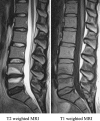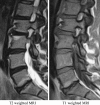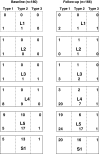Modic changes following lumbar disc herniation
- PMID: 17334791
- PMCID: PMC2219661
- DOI: 10.1007/s00586-007-0336-8
Modic changes following lumbar disc herniation
Abstract
Only a small proportion (20%) of patients with LBP can be diagnosed based on a patho-anatomical entity. Therefore, the identification of relevant subgroups, preferably on a patoanatomical basis, is strongly needed. Modic changes have been described by several authors as being closely linked with LBP. The aims of this study were to describe the prevalence of Modic changes, their development as well as their association to LBP, previous disc contour, and surgery in patients with previous severe sciatica. This is a longitudinal cohort study where the patients were recruited from an RCT comparing two active conservative treatments, the 181 patients, who at baseline had radicular pain in or below the knee; all underwent a physical examination and MRI. MRI's, pain history and physical examination of 166 patients were obtained at follow-up 14 months later. The prevalence of Modic changes type 1 increased from 9% at baseline to 29% at follow-up. At that time, a strong association between Modic changes and non-specific LBP was noted. Apparently, Modic changes type 1 was more strongly associated with non-specific lumbar pain than Modic changes type 2. The development of new Modic changes was closely related to the level of a previous disc herniation. A lumbar disc herniation is a strong risk factor for developing Modic changes (especially type 1) during the following year. Furthermore, Modic changes are strongly associated with LBP.
Figures





References
-
- Albert HB (2004) Conservative treatment of patients with sciatica—a randomized controlled trial. (Dissertation) Odense, Faculty of Health Sciences, University of Southern Denmark
-
- Boden SD, Davis DO, Dina TS, et al. Post-operative diskitis: distinguishing early MR imaging findings from normal post-operative disc space changes. Radiology. 1992;184:765–771. - PubMed
-
- Crane R. The post-operative lumbar spine. Acta Radiol Suppl. 1998;414:1–23. - PubMed
MeSH terms
LinkOut - more resources
Full Text Sources
Other Literature Sources
Medical
Miscellaneous

